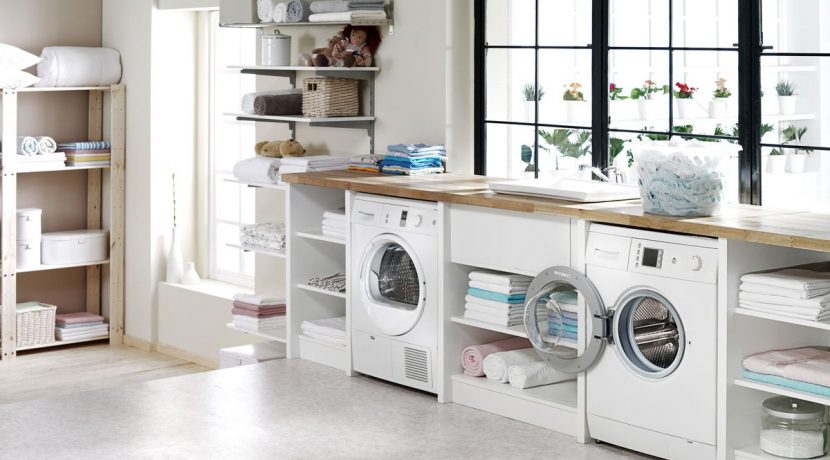If washing clothes sometimes feels like pure drudgery, one reason might be your laundry room. Designers and builders of new homes typically leave this room plain and minimally functional. Older homes often have laundry rooms carved out of basement corners, poor lighting, bare concrete flooring, and nowhere to hang clothes or store laundry essentials.
Laundry room remodeling is easier, less expensive, and less painful than remodeling other areas of the home. Water supply and drainage are easy to tap into since the washer and dryer are already installed. Remodeling materials tend to be low-cost and basic. And because the laundry room is peripheral, remodeling does not take a core room—such as a kitchen or bathroom—out of commission for long periods.
Install Comfortable Flooring
Bare, unfinished flooring, whether concrete or uncovered subfloor, is no joy to walk on or spend any amount of time standing on. Uncomfortable and gloomy, unfinished flooring is one of the more prominent signals that this laundry room is, on the whole, unfinished and in need of serious care.
If your home’s floor covering does not extend into the laundry room, cover the laundry room with a good, basic, inexpensive, and waterproof floor covering. Luxury vinyl plank and ceramic tile flooring both stand up well against water, even minor amounts of pooled water. Avoid installing moisture-intolerant flooring such as solid hardwood.
Add Improved Lighting
If a single ceiling light or fluorescent light is the extent of your laundry room’s lighting system, you need new lighting. Dim lighting makes it more difficult to do your laundry work, and many homeowners find fluorescent lighting unpleasant.
Convert that single ceiling light to a series of intelligently placed recessed lights. That bank of fluorescent lights can be removed and replaced with track lighting, recessed lights, or with an attractive flush-mount ceiling light. If you have wall cabinets, under-cabinet lights can be installed that add much-needed light for any project.
Create Folding Surfaces
Get that laundry folded and done before you take it out of the laundry room. If you have front-loading machines, one simple way to create a folding surface is to build a waterfall countertop—a three-part, U-shaped bridge that wraps over the top of the machines.
In large laundry rooms, take care of the problem swiftly by purchasing a permanent table. You can even build your own table. Smaller laundry rooms are better served with tables that fold down from the wall. Attached at one end by hinges, the other end has a fold-down table leg for additional support.
Build Laundry Organizers and Storage
If storage in your laundry room is tight or non-existent, you’re in good company. Most homeowners with separate laundry rooms report that they would love to have better storage and organizing capabilities. Possibilities include:
Wall cabinets installed at shoulder height or above
Small floating, cantilevered shelves for light-weight items
Glass-front pantry-style tall cabinets
Wheeled pull-out laundry baskets that tuck under countertops
Large barn doors that roll across the front of the washer, dryer, and open storage cubbies to hide them
Wall cabinets with the doors removed or left off for quick, easy access to items
Open bookcases requisitioned and used for laundry detergent and other supplies
Any type of furniture upcycled with coats of chalk paint
Install a Utility Sink
You may not know why you need a utility sink in your laundry room until you actually have one. Then you will realize the wide range of uses for this sink. You can wash out muddy and highly dirty clothes before putting them in the washer. You can soak or pre-treat items in utility sinks. And of course, there is an endless list of non-clothing related things you can do with a utility sink, from potting plants to washing out paintbrushes.
A utility sink or laundry sink can usually be installed in a laundry room with relative ease. The reason? Along with bathrooms, this is one room of the house that is guaranteed to have water supply and drainage lines. Unless the walls are open, you will need to remove drywall to access those lines and extend them at least 4 feet to clear the washer and dryer. Half-inch PEX pipes make short work of those water supply lines, with no need to work with copper pipe or learn how to solder.
All rights reserved to the initial publisher for The Spruce.
Collected and published by Arms &McGregor International Realty editorial team.

